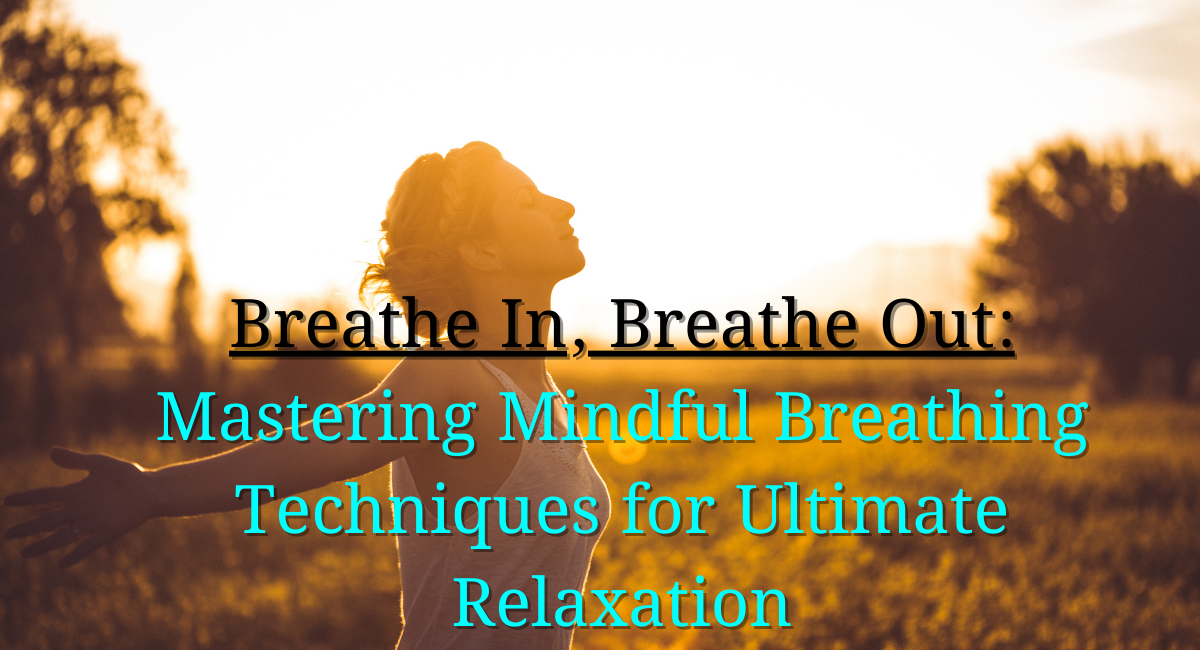Breathe In, Breathe Out: Mastering Mindful Breathing Techniques for Ultimate Relaxation, 101 Best Amazing Tips for Optimal Health and Well-being (Part 7/10)
In the hustle and bustle of everyday life, taking a moment to focus on your breath can be a powerful tool for relaxation and stress relief. This guide will explore the art of mindful breathing, providing deep breathing exercises to help you cultivate a sense of calm and tranquility.

1. Understanding Mindful Breathing: The Gateway to Relaxation
Introduction:
Mindful breathing is a practice rooted in ancient traditions, offering a direct path to calm the mind and soothe the nervous system.
Key Concepts:
– Present Moment Awareness: Mindful breathing brings attention to the present, fostering a sense of grounding.
– Stress Reduction: Deep breathing triggers the relaxation response, countering the effects of stress.
2. Diaphragmatic Breathing: A Foundation for Mindful Relaxation
Introduction:
Also known as belly or abdominal breathing, diaphragmatic breathing is a foundational technique for mindful relaxation.
Diaphragmatic Breathing Steps:
– Find a Comfortable Position: Sit or lie down in a relaxed position.
– Place Hand on Belly: Put one hand on your chest and the other on your abdomen.
– Inhale Slowly Through Nose: Inhale deeply through your nose, allowing your abdomen to rise.
– Exhale Gradually: Exhale slowly through your mouth or nose, feeling your abdomen fall.
– Repeat: Practice for a few minutes, gradually increasing duration.
3. 4-7-8 Breathing Technique: Calming the Nervous System
Introduction:
The 4-7-8 technique, popularized by Dr. Andrew Weil, is a simple but effective breathing exercise for relaxation.
4-7-8 Technique Steps:
– Sit or Lie Down Comfortably: Find a quiet space and adopt a comfortable posture.
– Inhale for 4 Counts: Inhale quietly through your nose for a count of 4.
– Hold Breath for 7 Counts: Hold your breath for a count of 7.
– Exhale Slowly for 8 Counts: Exhale completely and audibly through your mouth for a count of 8.
– Repeat the Cycle: Perform four breath cycles to start, gradually increasing as needed.
4. Box Breathing (Square Breathing): Finding Equilibrium
Introduction:
Box breathing is a rhythmic technique that involves equal parts of inhalation, breath retention, exhalation, and a pause, forming a square pattern.
Box Breathing Steps:
– Inhale (Count of 4): Inhale slowly through your nose for a count of 4.
– Hold (Count of 4): Hold your breath for a count of 4.
– Exhale (Count of 4): Exhale gradually and completely for a count of 4.
– Pause (Count of 4): Hold your breath again for a count of 4.
– Repeat the Sequence: Continue the box breathing pattern for several cycles.
5. Alternate Nostril Breathing (Nadi Shodhana): Balancing Energies
Introduction:
A traditional yogic breathing technique, Nadi Shodhana, or alternate nostril breathing, aims to balance the two hemispheres of the brain.
Alternate Nostril Breathing Steps:
– Sit Comfortably: Adopt a comfortable seated position.
– Use Right Thumb and Ring Finger: Close your right nostril with your right thumb and inhale through your left nostril.
– Close Left Nostril: Use your ring finger to close your left nostril as you release the right nostril, exhaling through the right.
– Repeat the Cycle: Continue alternating nostrils for several breath cycles.
Conclusion:
Mindful breathing techniques offer a refuge in the present moment, providing a sanctuary of calm amidst life’s chaos. Incorporate these deep breathing exercises into your routine to cultivate relaxation, reduce stress, and enhance overall well-being.
FAQs about Mindful Breathing:
1. How often should I practice mindful breathing exercises?
– Aim for a few minutes of mindful breathing daily, gradually increasing the duration as you become more comfortable with the practice.
2. Can mindful breathing help with anxiety?
– Yes, mindful breathing has been shown to reduce symptoms of anxiety by promoting relaxation and calming the nervous system.
3. Is there a specific time of day to practice these techniques?
– Choose a time that suits your schedule and allows for a quiet, uninterrupted experience. Many find mornings or before bedtime to be ideal.
4. Can I practice mindful breathing in a group setting?
– Absolutely. Mindful breathing can be practiced individually or in group settings, fostering a sense of collective calm.
5. Are there variations of these techniques for beginners?
– Start with shorter durations and simpler techniques, gradually progressing as you become more comfortable with the practice.
- Hydration Unleashed: Hacks for Staying Adequately Hydrated for Optimal Well-being, 101 Best Amazing Tips for Optimal Health and Well-being (Part 6/10)
- 101 Best Amazing Tips for Optimal Health and Well-being (Part 5/10), Sleep Sanctuary: Unveiling the Importance of Quality Sleep and Tips for Restful Nights
- 101 Best Amazing Tips for Optimal Health and Well-being (Part 4/10), Mind Matters Strategies for Stress Management and Mental Well-being
- 101 Best Amazing Tips for Optimal Health and Well-being (Part 3/10), Move Your Way to Wellness: Embracing Physical Activity for a Healthier You
- Healthy Eating Habits: 101 Best Amazing Tips for Optimal Health and Well-being, Nourishing Wellness- A Guide to Healthy Eating Habits (Part 2)






